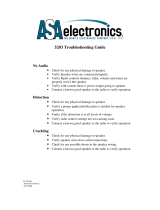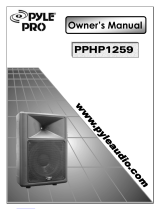
8 ohm cabinets. Note that measuring speaker cabinets using an ohm meter will not give accurate results because ohm meters read
DC resistance not AC impedance. AC impedance will always be greater than the DC resistance, a typical 8 ohm speaker will usually
measure between 5 and 7 ohms, a typical 4 ohm speaker will usually measure between 2.5 and 3.5 ohms.
SPEAKER POLARITY (OR PHASE)
All speakers have “polarity”, that is a speaker wired to the industry standard will move
forward with a positive DC voltage applied to the positive terminal of the speaker and a negative voltage applied to the negative
terminal of the speaker. While there are standards, there are also deviations from standards, either by legacy (ie. early JBL drivers),
by faulty repair (incorrectly wired cabinet or defective recone parts) or a manufacturer choosing to ignore the standard. If a multi-
driver speaker cabinet or a pair of speaker cabinets does not appear to have the expected output or low end, it’s always a good
idea to double-check that all drivers move forward with positive DC voltage applied to the + terminal (this will be the 1+ terminal on
a SpeakOn™ connector, or the tip on a 1/4” connector). If you find on a multi-speaker cabinet that one speaker moves out while the
other does not move, it’s likely that the non-moving driver has failed or has become disconnected. If one driver moves out while the
other driver moves in, it’s likely that the driver moving in is wired incorrectly or in a sealed cabinet is failed or disconnected and is
merely being moved in the opposite direction by the air mass inside the cabinet itself. Being aware of these possibilities can often
help when something is not quite right.
HEADPHONE OUTPUT
The Subway D-800 includes a 1/4” TRS (tip-ring-sleeve) headphone output jack, which will drive all
common headphones and IEM ear pieces between 8 and 32 ohms. It’s advisable to use caution whenever sticking a sound source
in your ear, as damaging volume is possible, especially with “bass player accidents” and when volume is factored over a long period
of time. This output contains additional cabinet emulation circuitry.
AUX INPUT
The amplifier is provided with a 1/4” TRS AUX input. This TRS stereo jack properly sums left and right channels
from an MP3 player, i-device, or laptop as many of these new devices do not contain adequate build out resistors for proper sum-
ming. The signal injection point is right before the master volume control, so you can use the instrument’s volume control to balance
the level between your bass and the playback device. Note that for best performance, a 1/8” TRS to 1/4” TRS cable (also called a
stereo cable) is used, this will always match between devices and allow the amplifiers automatic summing circuitry to work properly.
DIRECT OUTPUT (DI OUT)
A feature that sets your new SUBWAY D-800 apart from the rest of the market is the inclu-
sion of a studio grade XLR balanced direct output. This output is capable of driving balanced analog lines as long as 500 feet, is
fully phantom power protected, is noise resistant and stability compensated for a reliable, high quality signal. This output follows the
pro audio standards of pin 2=non-inverting, pin 3=inverting and pin 1=ground. Every known console in the world follows this wiring
standard, so your SUBWAY will interface seamlessly to the Console of your choice.
PRE/POST DI OUT SWITCH
This switch selects the signal source routing that is used to derive the DIRECT OUTPUT signal.
In the PRE position, the signal is sourced directly from the input buffer and the active/passive switch sets the operating gain to provide
a more uniform signal level to the PA. Putting the amp in a sort of Standby Mode via the Front Panel MUTE switch defeats this output
for silent tuning. In the POST position, the signal is sourced from the output of the 4-Band Equalizer and before the master volume
control. Generally, for PA use the FOH (front of house) engineer will probably prefer a PRE EQ send because the capability of his PA
system may be significantly different than the stage rig and the EQ that you use on stage to sound good to you may not work on a
bigger system and in a larger acoustic space than just the stage. For recording, depending on the tracking goals of the engineer, either
PRE or POST might be used. When using the amp as a preamp (into a pro audio power amp or powered PA cabinet for example),
generally the POST position would be used and line level would be selected (unless the powered speaker can accept mic level signal).
DI GROUND LIFT SWITCH
This switch disconnects (lifts) the circuit ground/earth/common connection from pin 1 on the
XLR DI OUT connector. Balanced outputs do not rely on the pin 1 or shield connection to transmit signal to the Console. While pin
1 is always connected to the console’s master ground bus, often (due to differences in potential of a building’s ground/earth system)
currents will flow between grounds if there is a common connection, resulting in hum. By lifting the ground at the sending (bass
amp) end, this allows the shielding to remain in place while breaking the ground current flow that is the cause for inducing hum into
the signal carrying pair of conductors. Now, the one thing that complicates this is that at very high (radio) frequencies, ground is not
PAGE 6






















